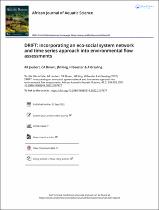| dc.contributor.author | Brown, CA | |
| dc.contributor.author | Joubert, AR | |
| dc.contributor.author | King, JM | |
| dc.date.accessioned | 2022-11-03T08:27:50Z | |
| dc.date.available | 2022-11-03T08:27:50Z | |
| dc.date.issued | 2022 | |
| dc.identifier.citation | AR Joubert, CA Brown, JM King, H Beuster & A Greyling (2022) DRIFT: incorporating an eco-social system network and time series approach into environmental flow assessments, African Journal of Aquatic Science, 47:3, 338-352, DOI: 10.2989/16085914.2022.2107477 | en_US |
| dc.identifier.uri | https://doi.org/10.2989/16085914.2022.2107477 | |
| dc.identifier.uri | http://hdl.handle.net/10566/8148 | |
| dc.description.abstract | DRIFT (Downstream Response to Imposed Flow Transformation) is an interactive, ecological-social process and software package to assist with environmental flow assessments and river management decision-making. It was originally developed in the 1990s and has subsequently evolved and been applied in over 50 studies in Africa, South America, Asia and Europe. Early versions provided predicted ecological responses over time to specific flow changes, while the latest version provides responses to flow and non-flow drivers as seasonal time series. Here, an ecosystem or eco-social network is built for the river, with links between driver and responder indicators, and relationships created for each link. The network and relationships are developed and entered into the software by specialists based on available data and their knowledge. A range of scenarios is explored through the predicted indicator time series, discipline and site level ecological integrity, and social well-being. While DRIFT models vary in complexity, they are all based on relatively simple fundamental principles and arithmetic. Sequential averaging and summation through the system network is used to calculate an indicator’s response to different drivers for successive seasons over time, while the discipline and site level summaries are found using weighted summation of indicator results and individual discipline results, respectively. Information from different specialist areas is therefore processed in the same way, thereby enabling coherent integration across disciplines. | en_US |
| dc.language.iso | en | en_US |
| dc.publisher | Taylor & Francis | en_US |
| dc.subject | ecosystems | en_US |
| dc.subject | hydropower | en_US |
| dc.subject | linked indicators | en_US |
| dc.title | DRIFT incorporating an eco-social system network and time series approach into environmental flow assessments | en_US |
| dc.type | Article | en_US |

